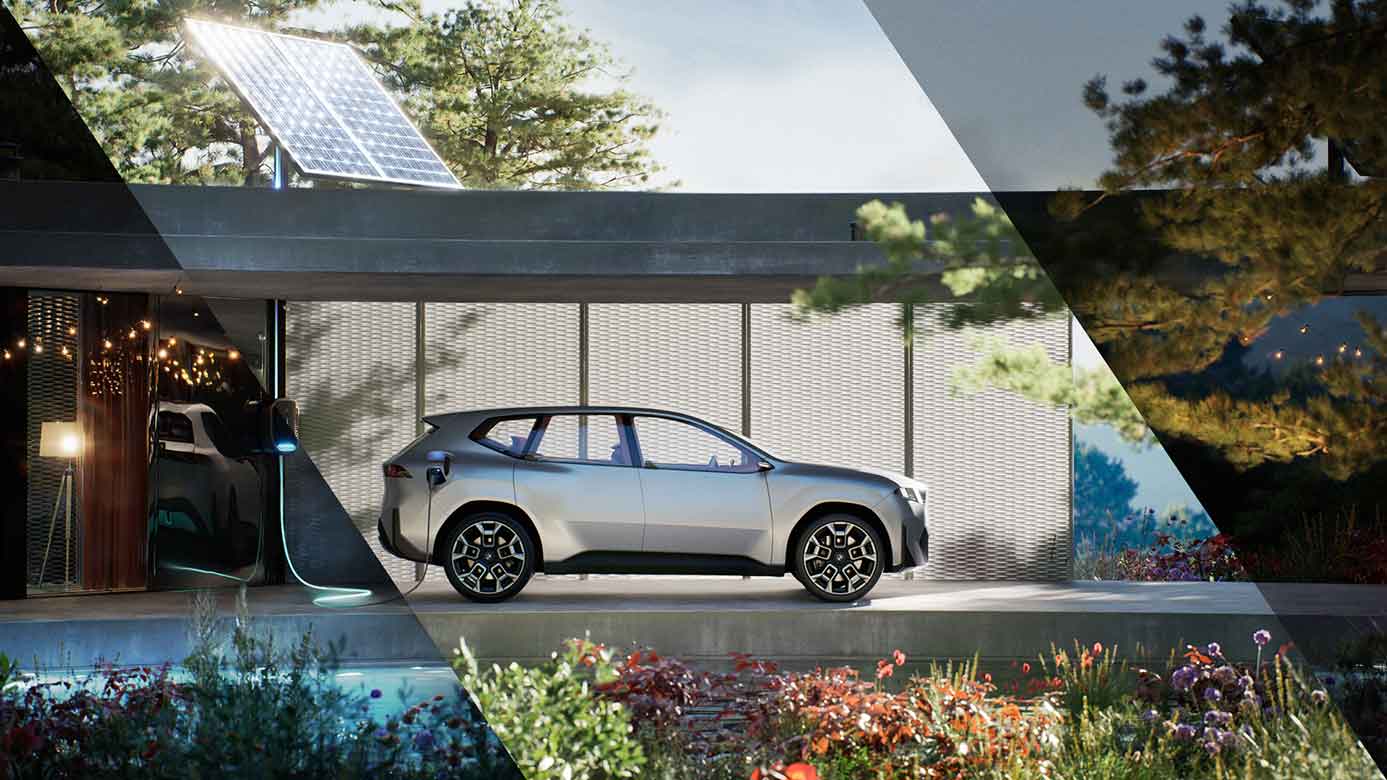2024 年 3 月 21 日
+++ Neue Klasse 车型配备双向充电 +++ 下一步技术提升重点关注智能充电 +++ 充电生态系统的新功能 BMW 互联家庭充电 +++
慕尼黑。计划于 2025 年推出的 BMW Neue Klasse 车型将能够储存电力并充当电源插座。它们配备了双向充电技术,即既能接受电力又能供电的能力。
通过最新的设计研究,BMW Vision Neue Klasse 轿车和 BMW Vision Neue Klasse X SAV,宝马集团展示了 BMW 品牌的下一代核心车辆的外观。它们代表了公司展示其未来生存能力的一系列技术创新。
随着 BMW Vision Neue Klasse X 的全球首发,宝马现在宣布另一项创新产品即将投入生产:双向充电功能。这项技术可以利用纯电动汽车的高压电池作为储能装置,并在后期将储存的电力返回到自己的家庭电源或电网。
这使得宝马客户能够更轻松地积极为能源转型做出贡献,并促进可再生能源的可持续生产和使用。因此,宝马客户将首次可以使用“车辆到家”、“车辆到电网”和“车辆到装载”等功能。此举也凸显了宝马集团充电服务的持续扩张。
“我们不断改进我们的充电产品和服务范围,以便最大限度地为客户带来利益,”负责开发的宝马公司管理委员会成员 Frank Weber 表示。“从今年夏天开始,我们将与我们的合作伙伴 E.ON 一起在多个市场提供成本优化的充电服务。对于 Neue Klasse,我们将采取下一步:双向充电。车到户和车到电网,全部完全集成到我们的综合充电生态系统 – BMW 互联家庭充电中。使用车辆、My BMW 应用程序、BMW 后端以及 BMW DC Wallbox Professional 及其光伏系统,客户将能够控制能量流,以便有时可以离网进行家庭充电。当然,他们还可以通过将宝马储存的电力回馈电网来降低充电成本。”
车到家:为您的家庭提供电力
在该技术的初始阶段,双向充电将使客户能够基本上将车辆的高压电池用作固定能量存储设备。在这里,客户的光伏系统产生的碳中和电力在 BMW DC Wallbox Professional 的帮助下暂时存储在车辆电池中,然后反馈给家里的其他用电设备,使客户独立于外部电源暂时并网并降低能源成本。
车辆到电网:馈入网络
双向充电的第二阶段将允许客户将部分电池容量提供给外部。这种能量容量既可用于从电网充电,也可在适当的时间向电网放电。宝马合作伙伴 E.ON 提供进入能源市场的机会。为此,客户将需要 E.ON 的动态电价,E.ON 将与 BMW 后端一起管理充电流程,以便通过能源交换创收。
只有采取必要的监管措施后,该功能才会在各个市场上提供。
车辆装载:汽车作为移动电源
车辆到负载功能允许使用车辆中存储的能量为外部电气设备供电。这意味着 Neue Klasse 可以兼作移动电源,例如为电动自行车充电,或在露营时为电气设备供电。
无论使用哪种类型的双向充电,客户对移动性的渴望始终是第一位的。这是通过“我的 BMW 应用程序”中直观、简单的操作来确保的,该应用程序可用于控制整个 BMW 互联家庭充电生态系统。
加速能源转型
双向充电不仅保证了更大的供电安全。通过接受和供应电力,电动汽车可以为可再生能源的电力消耗份额做出重大贡献。利用高压电池提供的存储能力可以更好地协调绿色电力领域的供需。例如,电动汽车存储系统可以选择性地吸收风能和太阳能发电高峰,并在发电量低时(夜间、间歇期)再次释放电力。这使得减少化石发电厂的启动及其在此期间的排放成为可能。通过这种方式,电动汽车正在成为能源革命中越来越不可或缺的一部分。通过双向充电,可以减少移动领域和整体发电领域的CO 2排放。
New energy for Neue Klasse: e-cars as energy storage
21.03.2024
+++ Bidirectional charging comes with Neue Klasse models +++ Next technology boost focuses on intelligent charging +++ New functions for the charging ecosystem BMW Connected Home Charging +++
Munich. BMW Neue Klasse models scheduled for launch in 2025 will be able to store electricity and function as a power outlet. They are equipped with technology for bidirectional charging – i.e. the ability to both accept and supply electricity.
With the latest design studies, the BMW Vision Neue Klasse sedan and the BMW Vision Neue Klasse X SAV, the BMW Group is showing what the next generation of core vehicles from the BMW brand will look like. They represent the range of technological innovations with which the company is showcasing its future viability.
With the world premiere of the BMW Vision Neue Klasse X, BMW is now announcing another innovation set to enter production: the ability to charge bidirectionally. This technology makes it possible to use the high-voltage battery of an all-electric vehicle as an energy storage device and to return the cached electricity to either your own household supply or the power grid at a later stage.
This makes it even easier for BMW customers to actively contribute to the energy transition and promotes the sustainable generation and use of renewable energy. Functions such as “Vehicle to Home”, “Vehicle to Grid” and “Vehicle to Load” will therefore be available to BMW customers for the first time. This move also underlines the ongoing expansion of the BMW Group Charging offer.
“We are constantly improving our range of charging products and services in order to maximise the benefit to the customer,” says Frank Weber, member of the Board of Management of BMW AG, responsible for Development. “Starting this summer, we will be offering cost-optimised charging together with our partner E.ON in a number of markets. And with the Neue Klasse we will be taking the next step: bidirectional charging. Vehicle to Home and Vehicle to Grid, all fully integrated into our comprehensive charging ecosystem – BMW Connected Home Charging. Using the vehicle, the My BMW App, the BMW backend – plus a BMW DC Wallbox Professional and their photovoltaic system, customers will be able to control the energy flow in such a way that home charging is possible off grid at times. And, of course, they will also be able to lower their charging costs by feeding the electricity stored in their BMW back into the power grid.”
Vehicle to Home: electricity for your household
In the technology’s initial stage, bidirectional charging will enable customers to essentially use their vehicle’s high-voltage battery as a stationary energy storage device. Here, the carbon-neutral electricity generated by the customer’s photovoltaic system is temporarily stored in the vehicle’s battery with the help of the BMW DC Wallbox Professional and then subsequently fed back to power other consumers in the home, making the customer independent from the external power grid for a time and reducing their energy costs.
Vehicle to Grid: feeding into the network
The second stage of bidirectional charging will allow customers to make a portion of their battery’s capacity available externally. This energy capacity can be used for both charging from the grid and discharging electricity into it at appropriate times. Access to the energy market is provided by BMW cooperation partner E.ON. To do this, customers will need the dynamic electricity tariff from E.ON, who will manage the charging process together with the BMW backend to enable revenue generation from the energy exchange.
This function will only become available in the various markets once the necessary regulatory measures have been adopted.
Vehicle to Load: the car as a power bank
The vehicle to Load function allows energy stored in the vehicle to be used for powering external electrical equipment. This means the Neue Klasse can double as a form of mobile power bank for charging an e-bike, for example, or supplying energy to electrical equipment while camping.
Regardless of which type of bidirectional charging is used, the customer’s desire for mobility always comes first. This is ensured by intuitive and easy operation in the My BMW App, which can be used to control the entire BMW Connected Home Charging ecosystem.
Accelerating the energy transition
Bidirectional charging not only ensures greater supply security. By both accepting and supplying electricity, electric vehicles can make a significant contribution to the share of electricity consumption coming from renewable sources. Using the storage capacities provided by high-voltage batteries allows supply and demand in the area of green electricity to be better coordinated. For example, electric vehicle storage systems can selectively absorb peak wind and solar energy generation and release the electricity again during periods of low generation (night, lulls) in supply. This makes it possible to reduce the start-up of fossil power plants and their emissions during such periods. In this way, electric mobility is becoming an ever more integral part of the energy revolution. With bidirectional charging, CO2 emissions can be reduced both in the area of mobility and in power generation overall.



